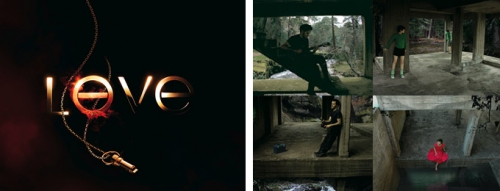Invitation to a creative space
Since its establishment in 1847, the French jeweler and watch manufacturer Cartier has continued to produce modern jewelry that is ahead of its time. The Fondation Cartier pour l’art contemporain, which was founded as a part of the company’s arts sponsorship program, has also gained an international reputation for its innovative approach to corporate patronage of the arts.
Research/text: ART iT
Fondation Cartier pour l’art contemporain was founded in 1984 by Alain Dominique Perrin, then president of Cartier International, on a suggestion by the sculptor Cesar. In 1986, it submitted a report on corporate sponsorship of the arts to the French Minister of Culture, and since then it has continued to actively demonstrate the kind of role corporations can play in the arts sector. In 1994, the Fondation Cartier moved its premises from the suburbs of Paris to the city’s heart. The new glass-walled exhibition facility, which was designed by the architect Jean Nouvel, has since hosted numerous important exhibitions.
Monumental commissioned works
One of the unique characteristics of the Fondation’s activities is its collection of commissioned works. Including both commissioned and non-commissioned works, the Fondation Cartier’s collection currently stands at over 1000 pieces representing the work of some 300 artists. Each year, an average of 15 new artworks selected by an international committee made up of experts from the art world are added to the collection. Last year, the Fondation presented its collection for the very first time in a major overseas exhibition at the Museum of Contemporary Art, Tokyo. Collection of the Fondation pour l’art contemporain included many works with a bold presence, such as Ron Mueck’s installation, which were able to be viewed from a completely new perspective, impressing upon visitors the results of the Fondation’s philanthropic work, which extends beyond the mere acquisition of artworks. The Fondation’s approach of giving artists carte blanche promotes completely unrestricted creative activities, enabling Marc Newson to create his jet plane, for example. Helene Kelmachter, who since 1994 has been working as curator at Fondation Cartier pour l’art contemporain alongside the Fondation’s director, Herve Chandes, explains:
“The commissions are an important part of the Fondation Cartier’s identity. For almost every exhibition, we commission new works from artists. That gives us the opportunity to be close to the creative process and to provoke a real dialogue with the artist. For the artist, it is usually a good opportunity to create a work that he has always been dreaming about, like in the case of Marc Newson. Commissioning a work is like giving an artist an invitation to play with our exhibition space, its huge volumes and its transparency. Therefore, the artists, in many cases, wish to create monumental pieces.”
Patronage open to new regions and new fields
The Fondation Cartier has also been active in introducing Japanese artists to Europe. In many cases the Fondation’s work serves as a steppingstone for later activities, such as when in 2002 it hosted the first major exhibition in Europe produced by Murakami Takashi.
“The Japanese artists we have exhibited at the Fondation Cartier pour l’art contemporain belong to various fields and various generations. Each is really inventing a very original and personal universe. I am very interested in the way they are inventing a contemporary art scene that deals with a strong relationship to a tradition that is still very much alive. What is also remarkable is the strong role of very young and talented Japanese women artists on the contemporary art scene.”
The J’en reve exhibition, organized in summer 2005, gathered together 58 artists in their 20s or early 30s from 23 countries, including Matsui Erina, Kunikata Mahomi, and Kojima Sako. This year, some of the artists who exhibited at that show will be taking part in a campaign organized by Cartier corporate in collaboration with the Fondation.
“On June 8, which we’ve designated LOVE Day, Cartier will launch a website devoted to love. The team in charge of this project at Cartier wanted to involve contemporary artists, so the Fondation recommended some young artists. The website will feature new work by a total of nine artists, including Flavia Da Rin, Takeyama Yuko, Aoshima Chiho, Takano Aya, and Tsai Charwei, who were asked to react to the question, How far would you go for LOVE?”
LOVE Day, which began last year with a charity event in New York City and has as its symbol Cartier’s LOVE bracelet, will be held again this year on an even grander scale. All the funding required to run the Fondation is provided by Cartier corporate, but the company also contributes in other ways to a variety of cultural and social causes.
The Fondation is currently hosting a David Lynch exhibition that runs through May 2007, after which it plans to hold an exhibition with Korean artist Lee Bul. As well, after the success of the Tokyo show, it is working on a world tour for the Fondation Cartier’s collection. Planning is also underway for some events for 2009 to mark the Fondation Cartier’s 25th anniversary, while Nomadic Nights, a weekly rendezvous focusing on the performing arts, continues to be a popular event.
“To always remain open and curious is a part of our identity,” says Kelmachter. It looks like we can look forward to the Fondation continuing to provide wide-ranging support for the arts in the future.

Left: Liza Lou, Back Yard, 1995-99
Right: Moriyama Daido, Polaroid Polaroid, 1997
Photos Kioku Keizo, courtesy Fondation Cartier

Left: Photo Akashi Shu 2007, courtesy Cartier
Right: Flavia Da Rin 2007, courtesy Cartier
Cartier
http://www.cartier.com/
Fondation Cartier pour l’art contemporain
261, Boulevard Raspail
75014 Paris
+33(0)1-42-18-56-50
http://www.fondation.cartier.fr
Originally printed in ART iT 15 Spring/Summer 2007
